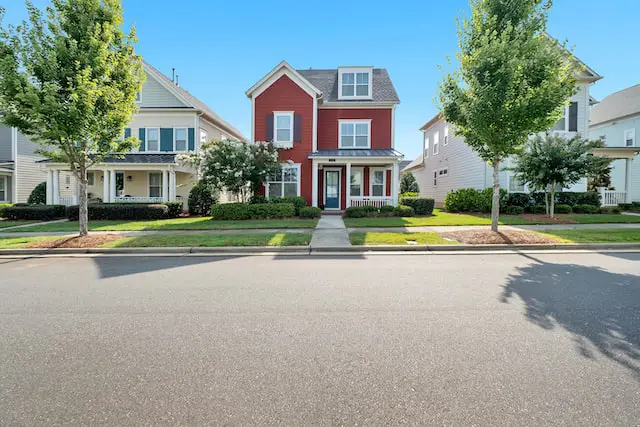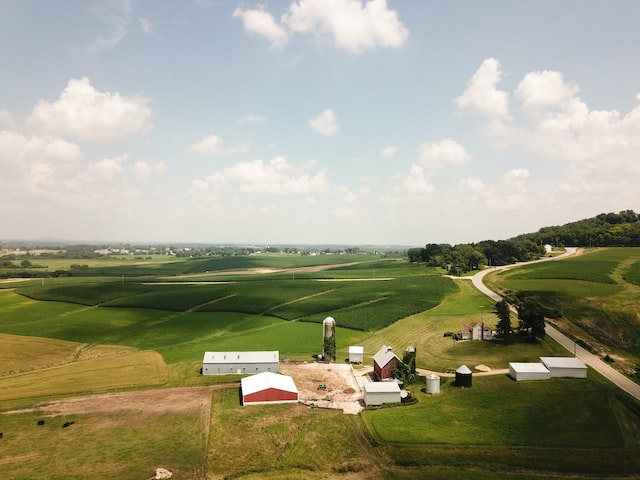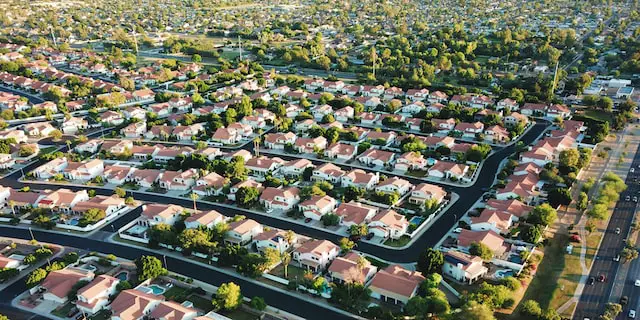Suburbs are residential areas located on the outskirts of cities and characterized by small, single-family homes and a more densely populated environment. Rural areas, on the other hand, are sparsely populated regions located outside of urban areas and are primarily used for agriculture, forestry, or other natural resource-based activities.
What is a suburban area?
(Photo by Zac Gudakov on Unsplash )

Suburbs are typically defined as areas that are located on the outskirts of urban areas. They are usually characterized by single-family homes, and may include small businesses and parks. Suburbs are often seen as more affordable than inner-city neighborhoods, and can provide a more family-friendly environment.
What is a rural area?
(Photo by John Reed on Unsplash )

Rural areas are typically defined as being outside of urban areas, often in more rural or agricultural settings. The U.S. Census Bureau defines a rural area as any place that is not part of an urban area, which they define as having a population of 50,000 or more. This means that rural areas can range from small towns to large expanses of farmland and everything in between.
What is the difference between suburban and rural areas?
The most obvious difference is that suburban areas are typically more densely populated than rural areas. This is because suburban areas are usually located near urban areas, which tend to be more populous. Suburban areas also tend to have more amenities and services than rural areas, such as shopping centers, restaurants, and schools.
Another key difference between suburban and rural areas is the type of housing that is available. In suburban areas, you will find a mix of housing types, including single-family homes, townhouses, and apartments. In contrast, rural areas typically only have single-family homes. This difference is due to the fact that it is easier to build multiple housing units in close proximity in suburban areas than it is in rural areas.
Suburban areas are typically more carefully planned out than rural areas. This planning includes things like the placement of roads and utilities, as well as the development of parks and other recreation facilities.
Suburbs are typically located on the outskirts of cities, while rural areas are usually located in more remote, countryside locations. This can have a big impact on things like commute times, access to amenities, and even the quality of the air.
Difference in development
Development in rural areas generally refers to the expansion of existing settlements, whereas development in suburban areas is often about creating new settlements. This means that there is typically more open space available for development in rural areas, but that the process of developing these areas can be more complex and expensive.
Rural development often focuses on improving infrastructure and services, as well as providing new opportunities for economic activity. This can include things like building new roads and schools, or expanding access to healthcare and broadband internet. In some cases, rural development can also involve re-purposing existing buildings or land for new uses.
Suburban development, on the other hand, is typically focused on creating entirely new settlements. This often involves lower density residential developments, as well as commercial and industrial parks. The process of suburbanization can be driven by a variety of factors, including population growth, changes in land use patterns, and transportation improvements.
Difference in services and infrastructure
In a suburb, you can typically find all the basic services you need – like grocery stores, gas stations, banks, etc. – within a short drive. But in a rural area, these same services may be miles away or non-existent. This can make everyday tasks like running errands or getting to work a real challenge.
Another big difference is the quality of public infrastructure. In suburbs, you’ll find well-maintained roads, sidewalks, and public transportation options. But in rural areas, these things are often in poor condition or completely nonexistent. This can make getting around difficult and dangerous.
Difference in population Density
The population density of an area is a measure of how many people live in that area. The higher the population density, the more people there are living in that area.
There are many factors that can contribute to the population density of an area. One is the size of the area. A smaller area will have a higher population density than a larger area because there are fewer places for people to live. Another factor is the resources available in an area. An area with more resources will be able to support a higher population density than an area with fewer resources.
The population density of suburbs is usually lower than the population density of rural areas. This is because suburbs are often larger than rural areas, and they often have more resources available.
Difference in land Use
There are a few different types of land use: residential, commercial, industrial, and agricultural. The type of land use dictates how the land can be used. For example, zoned residential areas are typically only for housing developments, while zoned commercial areas are meant for businesses.
Rural areas are typically used for agricultural purposes, while suburbs are developed for a mix of both residential and commercial use. The main difference between these two types of areas is the density of development. Rural areas have a lower density of development than suburban areas, which means there is more open space and fewer people per square mile.
Difference in Housing
In general, suburban homes are closer together and have more amenities than rural homes. They may be part of a planned community with common areas, such as parks or pools. Suburban homes also tend to be newer than rural homes.
Rural homes are typically larger and more spread out than suburban homes. They often have acreage and may be surrounded by farmland or forests. Rural homes may not have as many amenities as suburban homes, but they offer a sense of privacy and tranquility that is not always possible in a suburb.
What are the types of suburbs?
There are three types of suburbs: Inner, Outer, and Bedroom.
Bedroom suburbs are the most common type of suburb and are bedroom communities for larger cities. They are typically less racially and socioeconomically diverse than inner suburbs, but more diverse than rural areas. Outer suburbs are further away from the city center and often have higher crime rates and poverty levels. They also tend to be more racially and ethnically homogeneous than inner suburbs.
What are the types of rural areas?
Rural areas are typically classified as any population outside of an urban area. There are three types of rural areas:
Fringe rural areas are the least populous and most remote rural areas. They are often located on the outskirts of urban areas and can be difficult to access.
Remote rural areas are even more sparsely populated than fringe rural areas and are often located in more remote locations, such as mountainous regions or islands.
Very remote rural areas are the most isolated and sparsely populated of all rural areas. They are often located in extremely remote locations, such as the Arctic Circle or the Sahara Desert.
What are the advantages and disadvantages of living in the suburbs?
Advantages of living in the suburbs include:
- More affordable housing: Suburban areas tend to offer more affordable housing options than urban areas, with lower property values, lower rents, and more spacious homes.
- Quieter environment: Suburban areas are generally quieter and less congested than urban areas, making them more conducive to peaceful and private living.
- More green spaces: Suburban areas typically have more parks, nature reserves, and open spaces than urban areas, providing opportunities for outdoor activities and recreation.
- Better schools: Suburban areas often have better public schools than urban areas, with more resources and smaller class sizes.
Disadvantages of living in the suburbs include:
- Longer commutes: Suburban areas are often farther from urban centers and job hubs, requiring longer commutes and more time spent in traffic.
- Less diversity: Suburban areas are often less diverse than urban areas, with a more homogenous population and less exposure to different cultures and perspectives.
- Fewer cultural amenities: Suburban areas may have fewer cultural amenities, such as museums, theaters, and music venues, than urban areas.
- Limited public transportation: Suburban areas may have limited public transportation options, making it more difficult to get around without a car.
- Dependence on cars: Suburban areas are often designed for car travel, with few pedestrian-friendly areas or bike lanes, which can lead to a dependence on cars and contribute to traffic congestion and air pollution.
What are the advantages and disadvantages of living in rural areas?
Advantages of living in rural areas include:
- Lower cost of living: Rural areas typically offer a lower cost of living than urban or suburban areas, with lower housing costs, taxes, and living expenses.
- Quiet and peaceful environment: Rural areas are generally quieter and less hectic than urban or suburban areas, with less noise pollution and fewer distractions.
- Strong sense of community: Rural areas often have a strong sense of community, with close-knit neighborhoods and a supportive social network.
- Access to nature and outdoor activities: Rural areas are often surrounded by natural landscapes, providing opportunities for outdoor recreation such as hiking, fishing, and hunting.
- Fresh and healthy food: Rural areas often have access to fresh and locally grown produce and livestock, which can contribute to a healthier and more sustainable diet.
Disadvantages of living in rural areas include:
- Limited job opportunities: Rural areas often have fewer job opportunities than urban or suburban areas, with fewer employers and lower wages.
- Limited access to amenities: Rural areas may have limited access to amenities such as restaurants, shopping centers, and cultural attractions, requiring longer travel distances to access them.
- Lack of public transportation: Rural areas often have limited or no public transportation, making it difficult for residents without a car to get around.
- Limited access to healthcare: Rural areas may have limited access to healthcare services, with fewer healthcare providers and longer travel distances to medical facilities.
- Social isolation: Rural areas may be socially isolating, with fewer opportunities to meet new people or participate in social activities.
Featured Image By – Photo by Avi Waxman on Unsplash








